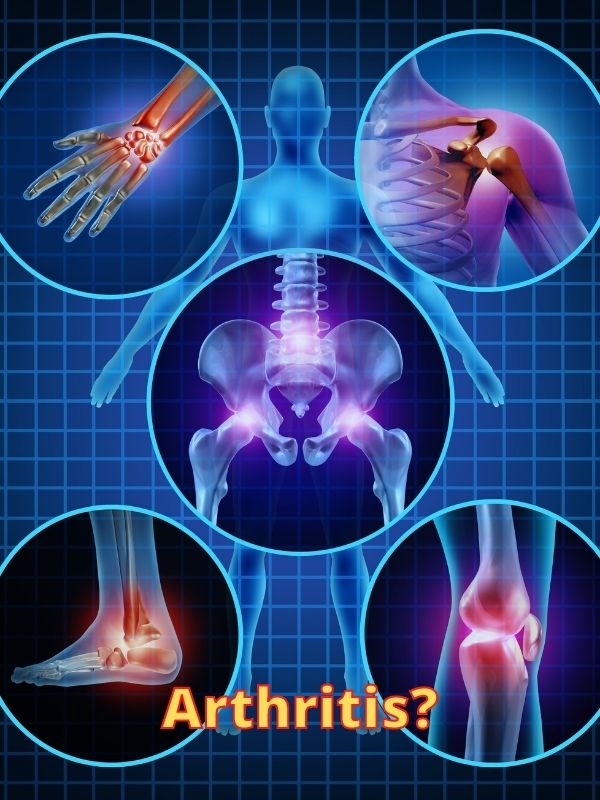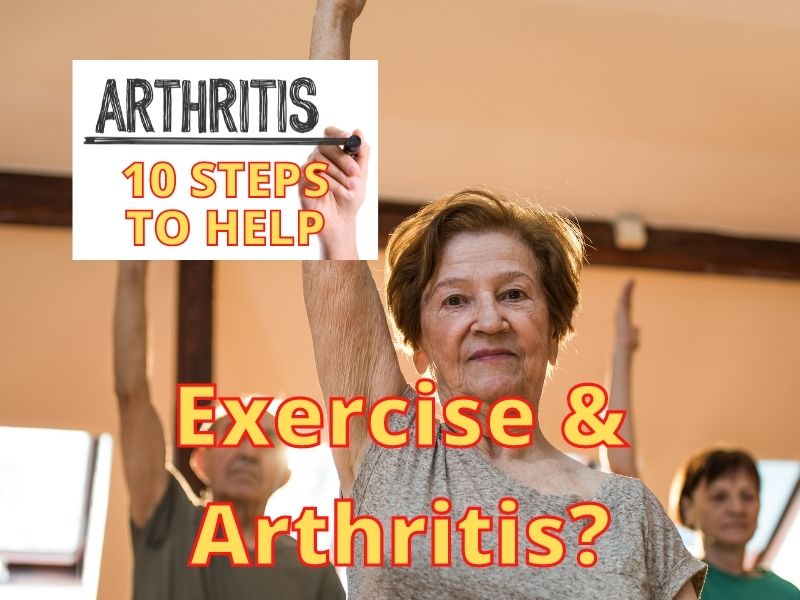You feel achy when you wake up in the morning and you know it’s time to take some pain medication so you can get through the day. Many people with arthritis find it difficult to think about exercise when they are just trying to reduce their pain.
Exercise may prevent some types of arthritis. If you already have arthritis, exercise can help relieve some of its symptoms. Exercise keeps joints healthy so they don’t develop arthritis, although cartilage tends to wear down more as we age. Some ideas to help prevent and deal with arthritis are the following.
- Repeat a Daily Pattern of Activities
- Get Help From Others for Support
- Make a List of Your Average Daily Activities
- Think About What You Normally Eat
- Drinking More Water and Plan a Diet
- Make an Exercise Plan
- Get Some Good Shoes
- Get Out of the House
- Physical Therapy
- Hot and Cold Packs
Arthritis usually comes with age as cartilage repair in our joints slows down. Keeping healthy can keep damage at bay longer, possibly your entire life, although rheumatoid arthritis is not preventable but can be slowed down.
What is Arthritis?

When the cartilage in your joints starts to wear down for one reason or another, you are developing arthritis. Arthritis is an inflammatory disease. Your joints are usually inflamed because of rubbing and they are asking for help.
You may have stiffness, swelling, and moving your arms and legs and other joints in a full range of motion is difficult.
Unfortunately, arthritis pain doesn’t really help those with arthritis because it prevents them from wanting to exercise and take care of their joints.
What Should You Do If You Have Arthritis?

Fortunately, there are some things you can do to help. Your body tried to signal that there’s a problem when you have pain.
If you start having pain it important to see a doctor to determine what the problem is. It may be an injury or arthritis.
If you have arthritis, your doctor will likely give you a list of ideas to help you manage pain and slow down the progress of the disease. You will likely get painkillers or other medicine.
There are many kinds of arthritis but two of the most common types of arthritis are:
- Osteoarthritis – The cartilage in your joints wears down and inflammation occurs.
- Rheumatoid Arthritis – The immune system attacks the joints (mostly hands and feet) and inflammation occurs.
Steps to Take
To start fighting for a better quality of life, you can start with a few simple steps. If you have a routine that you follow every day it may be easier for you to integrate some of these steps. A regular routine of healthy activities will help give you a higher level of well-being.
Here are some ways to get started on building a way of life that helps treat arthritis.
- Repeat a daily set of activities. Schedule a day worth of activities each day. You can focus more on doing, rather than any pain you may be feeling.
- Get help from others for support. A personal trainer, a friend to do activities with, family to talk to, and discussing your life on social media (if that helps) can be invaluable.
- Make a list of your average daily activities. Then determine what is important to you and what you are willing to modify if needed.
- Consider your eating habits. Eating healthy can directly affect how much inflammation your joint has.
- Drinking more water and plan a diet. Are you drinking enough water? Water and exercise help cushion joints. Eating a little better each day increases joint health as well.
- Make an exercise plan. Discuss with your doctor what types of exercise you need to do to help with your type of arthritis.
- Get some good shoes. Many soft cushioned shoes are able to provide shock absorption when you walk.
- Get out of the house. Getting out regularly with a friend or a group can help keep your feeling positive. Keeping your body moving is a great way to stay healthier. I find getting out into nature, helpful for me.
- Physical therapy may help. If you have osteoarthritis a physical therapist can work with you to help restore some range of motion and can give you helpful tips.
- Hot or cold packs. Inflammation can be treated with heat (to relax and relieve pain) and cold packs (to relieve swelling and pain).
What to do to Prevent Arthritis Symptoms?
Sometimes arthritis is unavoidable, such as with Rheumatoid Arthritis. Although, the most common type of arthritis is Osteoarthritis.
The joints have cartilage that starts to wear down with regular use. The problem that many people have when arthritis strikes is that they have not maintained healthy joints over time.
There are also other factors to consider such as how much use your joints have had, how much injury has occurred, and your genetics.
Maintaining Healthy Joints

To maintain healthy joints we need to move. Walking and various exercises help move synovial fluid in and out of your joints.
Synovial Fluid – Fluid that is produced in your joint to act as a lubricant between the bones in your joints. Little or no damage usually occurs when you have enough synovial fluid and are exercising with average exertion.
As you exercise, the joints start to:
- Receive nutrients – Blood is brought to joints.
- Repair themselves – Genes are turned on to repair the damage.
- Remove waste – Waste is taken out as damaged cells are broken down.
(Information about the joint gathered from – blog.arthritis.org)
Exercising brings you many health benefits as well as helping to maintain joint health. If you are having difficulties moving certain joints, there may be ways to move them with little pressure and less pain.
Your doctor can guide you about how far your arthritis has progressed and when exercising certain joints may no longer very helpful to relieve pain.
If your arthritis has progressed a lot, it may limit your ability to exercise, so help from others and specific guidance from your doctor can give you the direction you can take for the best results.
Eating For Joint Health
We can bring even more joint health by eating right. The food we eat can either nourish our joints as we exercise or cause inflammation.

—Here’s a list of foods that are helpful for arthritis.—
- Fish (Omega 3)
- Nuts
- Olive Oil
- Berries (fruits)
- Broccoli (vegetables)
Eating fresh foods, and avoiding fast food and many canned foods can help you get more nutrients to your joints.

—Here’s a list of foods that are NOT helpful for arthritis.—
- Sugar – refined sugar, syrup, fructose, sucrose, corn syrup, and other sugars. (Causes inflammation)
- Treats – Brownies, cookies, ice cream, candies, and sugary treats. (Causes inflammation)
- Drinks – Sodas, sports & energy drinks, hot cocoa, milkshakes, some teas, some flavored waters, some coffees/lattes, smoothies, and other sugary drinks. (Causes inflammation)
- White Flour products – white bread, white pasta, white flour tortillas, and other products with white flour. (Causes inflammation)
- High Fat Dairy Products – cheese, butter, mayo, and other high-fat dairy products. (Causes inflammation)
- Alcohol – Too much can cause inflammation.
(Information about the not helpful foods gathered from – arthritis-health.com)

5 Habits To Form For Healthy Joints
The habits we form stick with us. As we develop healthy habits it can help with our joint health.
- Sleep – At night is when the body repairs itself. We need to get allow the body time to rest so it can repair. One way to do that is by getting a good night’s rest. Enough movement throughout the day can help the body rest.
- Use Support – Avoid pain and injury by using a cane or walker. This will reduce inflammation, so we can do more throughout the day.
- Eat Regularly – As we get older we may require fewer calories, but we should make sure to get enough nutrients for our joints. Eating healthy foods at least three times a day can supply your body with the vitamins and minerals it needs.
- Move More – Moving around is helpful for our joints. We can do low-impact exercises, such as swimming or lying on the floor when exercising. We get stronger with less joint inflammation.
- Daily Effort – Make exercise and movement a daily habit will pay off in more consistent pain reduction.

10 Habits to Avoid For Healthy Joints
We can cause more pain and discomfort when we develop unhealthy habits that impact our joints. Runners, for example, can enjoy good joint health running for years, yet if they forget or neglect running safely they can receive an injury easily.
- Avoid Overexertion – Pushing too hard during exercise can lead to injury or exhaustion. This may put arthritic joints out of commission for long periods.
- Avoid Hard Strikes – The muscles are an important part of absorbing impacts. Locking out your joints and landing hard on your feet is not helpful and could cause harm. Past joint injuries may start to manifest as joint pain later in life.
- Avoid Getting Dehydrated – Water impacts proper joint and muscle function. It can influence joint damage if we are dehydrated often.
- Avoid Cold Muscles – Apply heat to your joints will help them feel better and help your muscles become less tight. This helps avoid getting pulled muscles. Another way to warm up the muscles is light exercise.
- Avoid Weights – Some people want to start off exercising with weights when it’s been years since they’ve used them. This can lead to injury. In addition, arthritis can be aggravated with more pressure on joints due to using weights.
- Avoid Short Recovery Time – Give your body enough time to recover after a workout.
- Avoid Weak Muscles – Work consistently toward increasing muscle strength. Not doing enough muscle strengthening can lead to injury because exercise movements are not controlled well. Stronger muscles reduce joint impact.
- Avoid Injury – A doctor can tell you if you need a knee brace or other supports to engage in exercises without risk of injury.
- Avoid Excess Repetition – Too much joint impact will cause inflammation and too much of the same exercise can lead to straining muscles and bones.
- Avoid Pride – Many people think can do exercise without preparing to ensure safe exercise procedures. They fly by the seat of their pants and go for it. This often leads to injury because they have gone beyond their limits.
What Treatment Can I Use for Arthritis?
Managing your arthritis can be difficult because you are not feeling well. It can be easy to sit or lie down for long periods to avoid the pain associated with moving around. What should you do to feel better? Below is information on treatment basics.
Arthritis Management
Most doctors will want to help you by giving you medication to help relieve the inflammation and pain. This is a helpful step towards managing your quality of life.
For some people, medicine is enough to help them get through the day and live the life they are used to. For others, they are still struggling to maintain a good quality of life and need something more.
When arthritis is causing too much pain to feel you can lead a normal life, you may feel you need to do something more to get back to the way things were.
Here are some ways to manage your arthritis pain on a daily basis.
Drink Water by Help Shoe- Drink Water – About 3/4 of all Americans are dehydrated. They aren’t getting the recommended amount of water their bodies need to function at full capacity. This is especially important for joint health.
- Water is needed in the joints to help lubricate them and to get rid of waste products in your body.
- Joints need water to help the cartilage in them stay hydrated.
- When I started drinking more water, I was able to feel more energetic and my mood seemed to be better during exercise.
- Muscles can function better with enough water.
- What about juice or flavored water? – Juices and flavor water can be fine in small quantities, like drinking a cup of orange juice with your breakfast, but it can become problematic when you drink more than that.
- Yes, some juices have anti-inflammatory antioxidants. So do many plants. So the best way to help with arthritis is to have a balanced approach.
- Most 100% of juices have too much sugar, and that can causes problems such as blood sugar spikes and diabetic issues over time.
- “Fructose needs to be processed by the liver and research suggests that a diet that is high in fructose may cause the liver to be overwhelmed, leading to problems such as non-alcoholic fatty liver disease and type 2 diabetes.” (diabetes.co.uk)
- If you feel like you need to have juice, blend 1/3 juice with 2/3 vegetable juice. That way you can drink 3 cups a day and it will be the same as one cup of juice.
- Keep Moving (but don’t overdo it) – Moving your joints that have arthritis can feel difficult. That’s why it a good idea to sit and lie down when you move your joints. You’ll be getting stronger muscles and helping the joints add fluid for better pain reduction. And because your exercising without putting pressure on your joints, that means less inflammation.
- Swimming can be a great way to move with a low impact on your joints.
- Stand and sit up straight if possible. Better posture means better back health and less pain.
- Walk slowly and control your movement for less joint impact.
- Many types of exercise can be great for your joint health.
- Get the right shoes for your feet. A comfortable walking shoe with arch support and soft cushioning can make a big difference for some.
- Medication – Likely, you’ll want to manage your pain with medication.
- Medicine with acetaminophen is helpful for pain reduction but you will need to take a medication with ibuprofen to help reduce swelling.
- Avoid taking too much medicine and drink plenty of water to help protect your liver.
- Use creams that help with the pain. Some have capsaicin (found in peppers) and others have menthol or camphor. You can also try pain relief cream with salicylates(pain reliever) and anesthetics that numb (lidocaine).
- Your doctor can give you steroids to reduce inflammation, but they have side effects, so doctors usually want you to try other treatments first.
- Another option that your doctor may provide is an injection into your joint. These can work for up to 6 months for some people.
- Surgery – If you’re in daily pain and your quality of life is low, you may feel you need to solve your arthritis with surgery. This option works well for some but is not the best option for everyone. There is always a risk involved with surgeries, including one where you don’t feel pain relief after healing.
- Your doctor can go over what type of surgery will be best for your type of arthritis and various available options.
- You could reshape the joint so they feel better when moving.
- You could replace a joint with an artificial one.
- You could fuse bones together for less flexibility and likely no more pain.
There are many options available depending on your situation. Yet, this option isn’t something I would recommend unless you’ve tried everything else and it hasn’t worked.
Weight Management by Help Shoe- Weight Management – Easier said than done, losing weight and keeping it off can be one of the most difficult challenges for those with arthritis, but it can have a dramatic effect on the overall quality of life.
- If you’re starting a diet, try making one change at a time. Maybe exchange one thing you normally eat each day with something different. For me, that change was eating more vegetables, instead of a sugary treat at lunch.
- Make a simple change in your schedule. I use to eat whatever was available at work to eat and there weren’t a lot of healthy options. So I set a time each evening for 5 minutes to prepare a healthier lunch for the next day.
- More water. I often feel like eating something sweet, yet if I drink a mouthful of water or two I feel fine for longer periods. I think sometimes we think we want to eat when we are actually thirsty.
- Reduce Stress – Stress creates cortisol, a stress hormone that leads to hunger. We want to eat unhealthy foods because those help us feel better temporarily. Cortisol is good for short bursts of energy during stressful times, but should never last for long. It can throw “our blood sugar level out of whack, interrupts our sleep (ever had that “tired but wired” feeling?!), leads to feelings of anxiety and depression, and affects wound healing.” (weightandwellness.com)
- As with any difficult change getting a support system is important. That could mean several things to different people, as long as you find a system that can consistently motivate you each day to work toward your goals.
There are many ways to manage arthritis so you can have a better quality of life. Setting goals that help you move forward is important. Discuss your thought with your doctor, friends, family, and online with positive support communities.
Then continue working on new goals and learn about other ways to help you live with less stress while you have arthritis.
Final Thoughts
Get yourself the care you deserve by proactively addressing arthritis. If you want to change your circumstances, it will take work, but by breaking problems into small goals you will be able to move forward and have a better quality of life.
I hope you can find the strength and hope needed to work towards goals that you set for exercise and treating your arthritis if you have it, or if you want to prevent it.
References
https://www.webmd.com/rheumatoid-arthritis/rheumatoid-arthritis-prevention
https://www.sharecare.com/health/arthritis-prevention/how-does-exercise-prevent-arthritis
https://www.mayoclinic.org/diseases-conditions/arthritis/diagnosis-treatment/drc-20350777
https://blog.arthritis.org/living-with-arthritis/exercise-benefits-for-joints
https://www.arthritis-health.com/blog/kitchen-arthritis-foods-avoid
https://www.diabetes.co.uk/food/juice-and-diabetes.html
https://www.healthline.com/health/arthritis-back-pain-exercises#walk
https://www.mayoclinic.org/diseases-conditions/osteoarthritis/in-depth/pain-medications/art-20045899
https://orthop.washington.edu/patient-care/articles/arthritis/basics-of-surgery-for-arthritis.html

